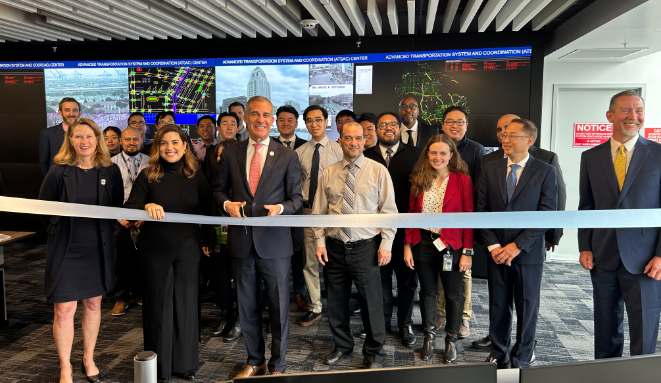California Construction News staff writer
The Los Angeles Department of Transportation (LADOT) cut the ribbon on the new Advanced Transportation System and Coordination (ATSAC) Center. The site controls the timing of traffic signals across Los Angeles and upgrades a system that was first established to support the 1984 Summer Olympic Games.
The expansion enables ATSAC to manage the increasing complexity of Los Angeles’ transportation system as well as prepare the city to host major events like the LA 28 Olympic and Paralympic Games.
“Safety and ease of mobility are critical elements of a world-class transportation system. As we prepare to welcome the world to our city for the Olympic and Paralympic Games in 2028, we are working to ensure that Los Angeles is both safe and accessible for all,” said Mayor Eric Garcetti.
“Through technology like ATSAC, our city will be ready to greet visitors from across the globe and reduce traffic for residents and visitors alike for generations to come.”
When the original ATSAC was established in 1984, the system managed 118 signals. Today, the system manages 4,850 traffic signals and provides prioritization for buses, rail, and pedestrians as well as manage bike signals throughout the city.
Additional functions include adaptive traffic signal control to react to changing traffic conditions as well as real time data on congestion and signal malfunction.
“Our ATSAC system is the nerve center that helps us keep LA moving — in all the various ways and modes in which Angelenos travel today,” said LADOT Interim General Manager Connie Llanos. “This facility brings our legacy system into the 21st century, improves the daily lives of all Angelenos, and helps prepare Los Angeles to host the world for the LA28 Olympic and Paralympic Games.”
A key benefit of the new facility is the expanded workspace which allows for specialized teams such as emergency response, special traffic operations, parking enforcement and traffic control command, and transit optimization.
“Our priority is to keep Los Angeles, fans, and athletes moving during the Summer of 2028, and we have the opportunity to catalyze a lasting positive impact on the region’s transportation system,” said LA28 CEO Kathy Carter. “Today’s unveiling shows continued progress using advanced technology that will not only play an integral role during the LA28 Olympic and Paralympic Games but will also improve Southern California’s mobility future – and we know it’s just the beginning.”
A Texas A&M Transportation Institute study showed that ATSAC reduces stopped delay on arterial streets by more than 32% and overall emissions by 3%.














